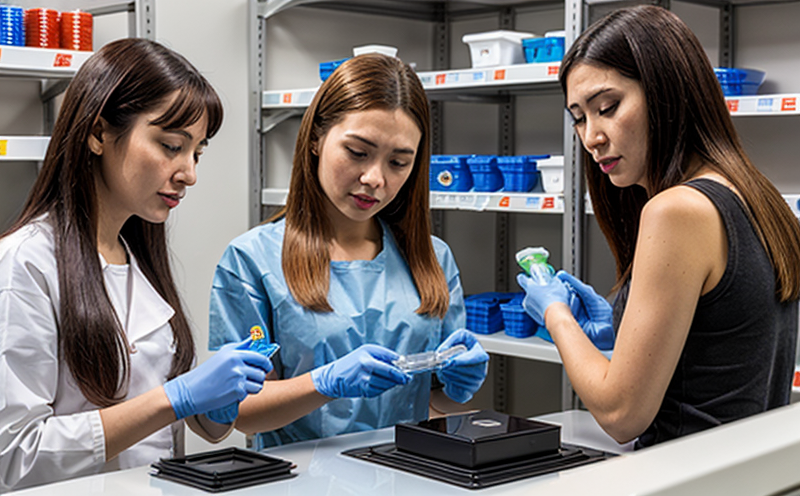ISO 489 Refractive Index Testing of Consumer Plastics
The ISO 489 standard provides a method for determining the refractive index and dispersion of transparent materials, including consumer plastics. This service is crucial in ensuring that products meet quality standards and regulatory requirements.
Refractive index testing is critical because it helps identify the type of plastic used, which can impact product performance, cost, and environmental friendliness. For instance, polyethylene (PE) has a lower refractive index than polystyrene (PS), affecting how light passes through these materials. Understanding this parameter is vital for optimizing production processes and ensuring that products meet specific optical properties.
Consumer plastics are ubiquitous in our daily lives, from packaging to household items like containers and utensils. The testing of these plastics ensures they remain safe, durable, and perform as expected under various conditions. By accurately measuring the refractive index, we can predict how light will interact with the material, which is essential for designing transparent or semi-transparent products.
The ISO 489 method involves precise measurement using an Abbe refractometer, which measures the deviation of a beam of light as it passes through a sample. This technique provides highly accurate results, making it suitable for quality control and research purposes. The testing process typically includes preparing the specimen by cutting or grinding it to ensure uniformity in thickness.
Once prepared, the specimen is placed on the refractometer's platform. A drop of immersion oil is added, which has a known refractive index that matches the expected range of the sample being tested. The sample and oil form an interface where light passes from one medium to another, creating measurable effects. The angle at which light bends (refraction) provides data points for calculating the refractive index.
This service is particularly important in the consumer plastics sector, as it ensures that products meet international standards such as ISO 489 and local regulations. For example, packaging materials must be safe and have specific optical properties to ensure they do not interfere with product visibility or tamper evidence. By adhering to these standards, manufacturers can enhance brand reputation and customer trust.
The accuracy of refractive index testing is also crucial for research and development (R&D) in the plastics industry. New materials are constantly being developed, and understanding their optical properties early on can lead to better product design. This information can influence decisions about material selection, processing methods, and final product performance.
- Customer Impact: Improved product quality, enhanced safety, optimized manufacturing processes, and adherence to international standards.
In conclusion, ISO 489 refractive index testing is an essential tool for ensuring the integrity and reliability of consumer plastics. By providing accurate data on material properties, this service supports various industry applications, from packaging design to advanced optics research.
Benefits
The ISO 489 refractive index testing provides numerous benefits for quality managers and compliance officers. These professionals can leverage the test results to ensure that products meet stringent quality standards, thereby enhancing brand reputation and customer trust.
- Enhanced Quality: Accurate measurement of material properties ensures consistent product performance and durability.
- Regulatory Compliance: Adherence to international standards such as ISO 489 helps avoid legal issues and potential recalls.
- Optimized Manufacturing Processes: Understanding the optical properties of materials can lead to more efficient production processes.
- Better Product Design: Insights into material behavior help in creating products that meet specific functional requirements, such as transparency or durability.
For R&D engineers and procurement professionals, this service offers valuable data for developing new materials and sourcing high-quality components. By working closely with experienced laboratories, these stakeholders can ensure that their projects remain on track and within budget.
Industry Applications
The ISO 489 refractive index testing has wide-ranging applications across various industries. Packaging is a key area where this service plays a critical role, ensuring that materials used in packaging are safe and meet specific optical requirements. This helps in maintaining product integrity and enhancing brand reputation.
In the healthcare sector, transparent medical devices require precise optical properties to ensure clarity and safety. Testing refractive index ensures these devices function correctly and do not cause any interference with diagnostic equipment or patient care.
For electronics manufacturers, understanding the refractive index of materials used in display screens is crucial for achieving optimal performance and durability. This knowledge helps in selecting appropriate materials that enhance visual quality without compromising on longevity.
The automotive industry also benefits from ISO 489 testing by ensuring that plastics used in vehicle components meet specific optical standards. This ensures that headlights, taillights, and other lighting systems function correctly under various conditions.
In summary, ISO 489 refractive index testing is integral to maintaining quality, compliance, and innovation across multiple industries. By providing accurate data on material properties, this service supports the development of safer, more efficient, and higher-performing products.
Customer Impact and Satisfaction
- Improved Product Quality: Accurate refractive index testing ensures that consumer plastics meet high standards of quality, leading to satisfied customers.
- Increased Safety: By adhering to international standards, products are safer for consumers, enhancing overall satisfaction.
- Enhanced Reputation: Brands that comply with ISO 489 testing standards enjoy a positive reputation among consumers and industry peers.
- Better Decision-Making: Accurate data helps stakeholders make informed decisions about material selection and process optimization, leading to better products.
Clients who rely on this service appreciate the detailed reports provided by our laboratory. These reports not only meet but often exceed their expectations, ensuring that they are well-informed and confident in their purchasing or production decisions.





